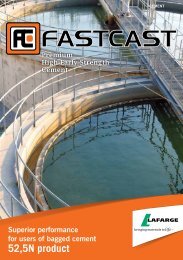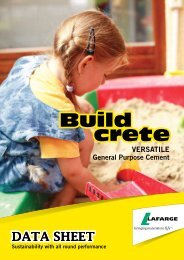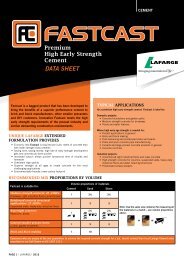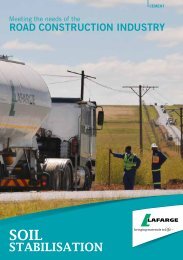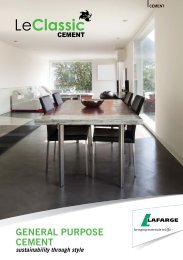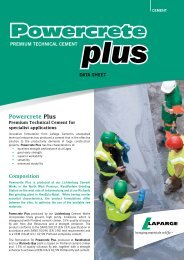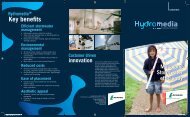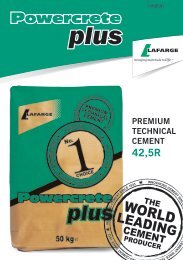Material Safety Data Sheet - Lafarge in South Africa
Material Safety Data Sheet - Lafarge in South Africa
Material Safety Data Sheet - Lafarge in South Africa
You also want an ePaper? Increase the reach of your titles
YUMPU automatically turns print PDFs into web optimized ePapers that Google loves.
CEMENT<br />
<strong>Material</strong><br />
<strong>Safety</strong> <strong>Data</strong> <strong>Sheet</strong><br />
for Portland cement, blended Portland<br />
cements and pozzolanic cements
Contents<br />
<strong>Material</strong> safety data sheet<br />
Section 1:<br />
Chemical product and<br />
company identification<br />
Section 2:<br />
Hazard <strong>in</strong>dentification<br />
Section 3:<br />
Composition / <strong>in</strong>formation<br />
on <strong>in</strong>gredients<br />
Section 4:<br />
First aid measures<br />
Section 5:<br />
Fire-fight<strong>in</strong>g measures<br />
Section 6:<br />
Accidental release measures<br />
Section 7:<br />
Handl<strong>in</strong>g and storage<br />
Section 8:<br />
Exposure controls and personal<br />
protection<br />
Section 9:<br />
Physical and chemical properties<br />
Section 10:<br />
Stability and reactivity<br />
Section 11:<br />
Toxicological <strong>in</strong>formation<br />
Section 12:<br />
Ecological <strong>in</strong>formation<br />
Section 13:<br />
Disposal considerations<br />
Section 14:<br />
Transpor <strong>in</strong>formation<br />
Section 15:<br />
Regulatory <strong>in</strong>formation<br />
Section 16:<br />
Other <strong>in</strong>formation<br />
Page 03<br />
Page 04<br />
Page 05<br />
Page 06<br />
Page 08<br />
Page 08<br />
Page 09<br />
Page 09<br />
Page 10<br />
Page 11<br />
Page 11<br />
Page 12<br />
Page 13<br />
Page 13<br />
Page 13<br />
Page 14<br />
Page 15
CEMENT<br />
<strong>Material</strong> <strong>Safety</strong><br />
<strong>Data</strong> <strong>Sheet</strong><br />
For common cements (SANS 50197-1)<br />
Dear <strong>Lafarge</strong> Cement User<br />
All materials of construction need to be treated with respect<br />
and handled safely: Portland cement and its related products<br />
are no exception. It is easy to forget this when they are so<br />
widely used as construction materials and such a familiar sight<br />
<strong>in</strong> our local hardware stores.<br />
In terms of the Occupational Health and <strong>Safety</strong> Act, 1993<br />
(Act No.85 of 1993) Regulation 1179 dated 25 August 1995,<br />
Portland cement is considered a ‘hazardous chemical’ and all<br />
manufacturers and sellers of the products(s) must provide an<br />
appropriate <strong>Material</strong> <strong>Safety</strong> <strong>Data</strong> <strong>Sheet</strong> (MSDS) to users and<br />
other potentially affected parties (e.g. emergency services).<br />
The categories of <strong>in</strong>formation supplied <strong>in</strong> the MSDS are also<br />
laid down <strong>in</strong> the regulations (SANS 10234 and SANS/ISO<br />
11014).<br />
The MSDS details the properties of the hazardous products,<br />
the precautions that should be taken when handl<strong>in</strong>g or work<strong>in</strong>g<br />
with cement, the potential health effects and recommended<br />
first aid measures.<br />
We recommend that you cont<strong>in</strong>ually rem<strong>in</strong>d your staff that a<br />
vital part of plann<strong>in</strong>g any job is to assess the safety precautions<br />
that will be necessary. Then, before any cement work is started,<br />
the appropriate personal protection equipment and first aid<br />
materials should be readily available.<br />
A truly successful project is a safe project!<br />
Yours s<strong>in</strong>cerely<br />
Emmanuel Ngubane<br />
National Market<strong>in</strong>g Manager – Cement<br />
<strong>Lafarge</strong> Industries <strong>South</strong> <strong>Africa</strong> (Pty) Ltd<br />
2011 | CEMENT MSDS | PAGE 3
Section 1:<br />
CHEMICAL PRODUCT AND COMPANY IDENTIFICATION<br />
Product names<br />
CEM IV / B-V 32,5 R - Buildcrete<br />
CEM IV / A-V 32,5 R - Buildcrete<br />
CEM IV / B-V 32,5 R - Le Classic<br />
CEM II / A-V 52,5 N - Fastcast<br />
CEM IV / B-V 32,5 R - Civilcrete<br />
CEM II / A-M (V-L) 42,5 N - Powercrete Plus<br />
CEM II / A-V 42,5 N - Powercrete Plus<br />
CEM II / A-V 52,5N - Rapidcem<br />
CEM II/B-M (V-S) 32,5N - RoadCem<br />
CEM IV / B-V 32,5N - DuraBuild<br />
Physical description and use<br />
Portland cement is a light grey powder that is used as a construction<br />
material <strong>in</strong> concrete, mortar and plaster. It is supplied <strong>in</strong> bulk<br />
form to large volume users and is also sold <strong>in</strong> paper bags, ma<strong>in</strong>ly<br />
50kg <strong>in</strong> size but also some <strong>in</strong> 25kg.<br />
MSDS <strong>in</strong>formation<br />
This MSDS was updated <strong>in</strong> October 2011.<br />
Chemical family<br />
Calcium salts. Predom<strong>in</strong>antly calcium silicate salts together with<br />
other calcium salts conta<strong>in</strong><strong>in</strong>g iron and alum<strong>in</strong>ium make up the<br />
major part of this product.<br />
Chemical name and synonyms<br />
Portland cement. Portland cement is also known as hydraulic<br />
cement.<br />
Formulation<br />
These products consist of f<strong>in</strong>ely ground Portland cement cl<strong>in</strong>ker<br />
mixed with a small amount of calcium sulphate (gypsum) and<br />
limestone. In Buildcrete, Durabuild, Civilcrete, Powercrete Plus,<br />
Rapidcem, Le Classic and Fastcast, fly ash is used as an extender<br />
constituent. In RoadCem, fly ash and Ground Granulated Blast-<br />
Furnace Slag (“slag”) are used as extenders.<br />
Supplier/Manufacturer<br />
<strong>Lafarge</strong> Industries <strong>South</strong> <strong>Africa</strong> (Pty) Ltd<br />
t/a <strong>Lafarge</strong> Cement<br />
35 Westfield Road<br />
Longmeadow Bus<strong>in</strong>ess Estate Ext 11<br />
Edenvale<br />
1609<br />
Manufactur<strong>in</strong>g sites:<br />
Lichtenburg Cement Works<br />
1 Manana Road<br />
Industrial Site<br />
Lichtenburg<br />
2740<br />
Randfonte<strong>in</strong> Gr<strong>in</strong>d<strong>in</strong>g Station<br />
R559, corner of Condor Drive and F<strong>in</strong>sbury Road<br />
Randfonte<strong>in</strong><br />
1759<br />
Richards Bay Gr<strong>in</strong>d<strong>in</strong>g Station<br />
1 Duralum<strong>in</strong> Duct<br />
Alton<br />
Richards Bay<br />
3900<br />
General contacts:<br />
018 633 3000 Lichtenburg Plant, North West Prov<strong>in</strong>ce<br />
0860 523 274 Longmeadow Head Office, Johannesburg<br />
011 415 2469 Randfonte<strong>in</strong> Gr<strong>in</strong>d<strong>in</strong>g Station, Gauteng<br />
011 972 6146 Kaalfonte<strong>in</strong>, Gauteng<br />
035 797 4836 Richards Bay, KwaZulu-Natal<br />
015 297 3573 Polokwane, Limpopo<br />
Emergency contacts:<br />
Health: (018) 633 3000<br />
Transportation: (018) 633 3000<br />
PAGE 4 | CEMENT MSDS | 2011
CEMENT<br />
Section 2:<br />
HAZARDS IDENTIFICATION<br />
Identification<br />
No GHS (Globally Harmonised System of classification and labell<strong>in</strong>g of chemicals) identity.<br />
Classification and label as per SANS 10234.<br />
Emergency Overview<br />
Portland cement is a light grey powder that poses little immediate hazard. A s<strong>in</strong>gle short-term<br />
exposure to the dry powder is not likely to cause serious harm. However, exposure of sufficient<br />
duration to wet Portland cement can cause serious, potentially irreversible tissue (sk<strong>in</strong> or eye)<br />
destruction <strong>in</strong> the form of chemical (caustic) burns. The same type of tissue destruction can occur<br />
if wet or moist areas of the body are exposed for sufficient duration to dry Portland cement.<br />
Potential Health Effects:<br />
Relevant Routes of Exposure:<br />
Eye contact, sk<strong>in</strong> contact, <strong>in</strong>halation, <strong>in</strong>gestion.<br />
Effects result<strong>in</strong>g from eye contact:<br />
Exposure to airborne dust may cause immediate or delayed irritation or <strong>in</strong>flammation. Eye contact<br />
by larger amounts of dry powder or splashes of wet Portland cement may cause effects rang<strong>in</strong>g from<br />
moderate eye irritation to chemical burns and bl<strong>in</strong>dness. Calcium oxide may cause acute corneal<br />
damage if sufficient amounts contact the cornea. Such exposures require immediate first aid (see<br />
Section 4) and medical attention to prevent significant damage to the eye.<br />
Effects result<strong>in</strong>g from sk<strong>in</strong> contact:<br />
Discomfort or pa<strong>in</strong> cannot be relied upon to alert a person to a hazardous sk<strong>in</strong> exposure.<br />
Consequently, the only effective means of avoid<strong>in</strong>g sk<strong>in</strong> <strong>in</strong>jury or illness <strong>in</strong>volves m<strong>in</strong>imis<strong>in</strong>g sk<strong>in</strong><br />
contact, particularly contact with wet cement. Exposed persons may not feel discomfort until hours<br />
after the exposure has ended and significant <strong>in</strong>jury has occurred. Exposure to dry Portland cement<br />
may cause dry<strong>in</strong>g of the sk<strong>in</strong> with consequent mild irritation or more significant effects attributable<br />
to aggravation of other conditions. Dry Portland cement contact<strong>in</strong>g wet sk<strong>in</strong> or exposure to moist or<br />
wet Portland cement may cause more severe sk<strong>in</strong> effects <strong>in</strong>clud<strong>in</strong>g thicken<strong>in</strong>g, crack<strong>in</strong>g or fissur<strong>in</strong>g<br />
of the sk<strong>in</strong>. Prolonged exposure can cause severe sk<strong>in</strong> damage <strong>in</strong> the form of (alkali) chemical burns<br />
and could cause “contact dermatitis”. Persons already sensitised may react to their first contact<br />
with the product. Other persons may only experience this effect, for the first time, after years of<br />
contact with Portland cement products.<br />
Effects result<strong>in</strong>g from <strong>in</strong>halation:<br />
Exposure to Portland cement may cause irritation to the moist mucous membranes of the nose, throat,<br />
and upper respiratory system. It may also leave unpleasant deposits <strong>in</strong> the nose. Portland cement<br />
may conta<strong>in</strong> trace amounts of free crystall<strong>in</strong>e silica. Prolonged exposure to respirable free crystall<strong>in</strong>e<br />
silica can aggravate other lung conditions and cause silicosis, a disabl<strong>in</strong>g and potentially fatal lung<br />
disease. Iron oxide conta<strong>in</strong>ed <strong>in</strong> fly ash, upon chronic exposure, may result <strong>in</strong> iron pigmentation of<br />
the lungs, siderosis, and benign pneumoconiosis. (Also see Carc<strong>in</strong>ogenic potential” below)<br />
Effects result<strong>in</strong>g from <strong>in</strong>gestion:<br />
Although small quantities of dust are not known to be harmful, ill effects are possible if larger<br />
quantities are consumed. Portland cement should not be eaten.<br />
Carc<strong>in</strong>ogenic potential:<br />
NTP, OHSA, or IARC do not list Portland cement as a carc<strong>in</strong>ogen. It may, however, conta<strong>in</strong> trace<br />
amounts of substances listed as carc<strong>in</strong>ogens by these organisations. Crystall<strong>in</strong>e silica, a potential<br />
trace level contam<strong>in</strong>ant <strong>in</strong> Portland cement, is now classified by IARC as a known human carc<strong>in</strong>ogen<br />
(Group 1). NTP has characterised respirable silica as “reasonably anticipated to be [a]<br />
carc<strong>in</strong>ogen”.<br />
Medical conditions, which may be aggravated by <strong>in</strong>halation or dermal exposure:<br />
Pre-exist<strong>in</strong>g upper respiratory and lung diseases.<br />
2011 | CEMENT MSDS | PAGE 5
Section 3:<br />
COMPOSITION / INFORMATION ON<br />
INGREDIENTS<br />
Component Name % CAS No.<br />
Tri-Calcium Silicate
CEMENT<br />
OHS – ACT EXPOSURE LIMITS<br />
TWA<br />
SHORT TERM<br />
OEL - RL<br />
OEL - RL<br />
Component Name ppm or mg/m³ ppm or mg/m³<br />
Portland cement<br />
(CAS# 65997-15-1)<br />
(Respirable dust)<br />
5 mg/m³<br />
(Total Dust)<br />
10 mg/m³<br />
Calcium Sulphate<br />
(Gypsum)<br />
(Respirable dust)<br />
5 mg/m³<br />
(Total dust)<br />
10 mg/m³<br />
Calcium carbonate<br />
(Respirable dust)<br />
5 mg/m³<br />
(Total dust)<br />
10 mg/m³<br />
Magnesium Oxide<br />
10 mg/m³<br />
Calcium Oxide<br />
2 mg/m³<br />
Crystall<strong>in</strong>e Silica Quartz<br />
0.05 mg/m³<br />
Quartz (Respirable) 0,4 mg/m³/(%Si0 2 +2)<br />
Chromates<br />
0.5 mg(Cr0 3 )/m³<br />
TWA = Time-weighted average exposure<br />
Note:<br />
OEL-RL = Occupational Exposure Limit - Recommended<br />
Limit for Hazardous Substances<br />
Trace constituents<br />
Portland cement is made largely from limestone (calcium carbonate) and other materials m<strong>in</strong>ed from<br />
the earth and is processed us<strong>in</strong>g heat provided by fossil fuels. As a result, trace amounts of naturally<br />
occurr<strong>in</strong>g, potentially harmful chemicals might be detected <strong>in</strong> the cement dur<strong>in</strong>g chemical analysis.<br />
For example, Portland cement may conta<strong>in</strong> up to 0.75% <strong>in</strong>soluble residue, some of which may be<br />
free crystall<strong>in</strong>e silica. Other trace constituents may <strong>in</strong>clude calcium oxide (also known as lime or<br />
quick lime), magnesium oxide, potassium sulphate, sodium sulphate, chromium compounds, and<br />
nickel compounds.<br />
2011 | CEMENT MSDS | PAGE 7
CEMENT<br />
Section 4:<br />
FIRST AID MEASURES<br />
Eyes<br />
Immediately flush eyes thoroughly with water. Cont<strong>in</strong>ue flush<strong>in</strong>g eyes for at least 15 m<strong>in</strong>utes,<br />
<strong>in</strong>clud<strong>in</strong>g under lids, to remove all particles. Call for medical assistance immediately.<br />
Sk<strong>in</strong><br />
Wash sk<strong>in</strong> with cool water and pH-neutral soap or mild detergent. Seek medical treatment <strong>in</strong> all<br />
cases of prolonged exposure to wet cement, cement mixtures, liquids from fresh cement products,<br />
or prolonged wet sk<strong>in</strong> exposure to dry cement.<br />
Inhalation of Airborne Dust<br />
Remove to fresh air. Seek medical help if cough<strong>in</strong>g and other symptoms do not subside. (Inhalation<br />
of large amounts of Portland cement requires immediate medical attention)<br />
Ingestion<br />
Do not <strong>in</strong>duce vomit<strong>in</strong>g. If conscious, have the victim dr<strong>in</strong>k plenty of water and call for medical<br />
assistance immediately.<br />
Section 5:<br />
FIRE-FIGHTING MEASURES<br />
Flash po<strong>in</strong>t*<br />
Lower Explosion Limit<br />
Upper Explosion Limit<br />
Auto ignition temperature<br />
Ext<strong>in</strong>guish<strong>in</strong>g media<br />
Special fire fight<strong>in</strong>g procedures<br />
Hazardous combustion products<br />
Unusual fire and explosion hazards<br />
* Unknown<br />
None<br />
None<br />
None<br />
Not combustible<br />
Not combustible<br />
None<br />
None<br />
None<br />
PAGE 8 | CEMENT MSDS | 2011
Section 6:<br />
ACCIDENTAL RELEASE MEASURES<br />
Collect dry material us<strong>in</strong>g a scoop. Avoid actions that cause dust to become airborne.<br />
Avoid <strong>in</strong>halation of dust and contact with sk<strong>in</strong>. Wear appropriate personal protective<br />
equipment as described <strong>in</strong> Section 8.<br />
Scrape up wet material and place <strong>in</strong> a disposable conta<strong>in</strong>er. Allow the material to<br />
“dry” before disposal. Do not attempt to wash Portland cement down dra<strong>in</strong>s. Dispose<br />
of waste material accord<strong>in</strong>g to local municipal regulations.<br />
Section 7:<br />
HANDLING AND STORAGE<br />
Keep Portland cement dry until used. Normal temperatures and pressures do not<br />
affect the material.<br />
Promptly remove dusty cloth<strong>in</strong>g or cloth<strong>in</strong>g which is wet with cement liquids and<br />
launder before reuse. Wash thoroughly after exposure to dust or wet mixtures or<br />
liquids.<br />
2010 | CEMENT MSDS | PAGE 9
Section 8:<br />
EXPOSURE CONTROLS AND PERSONAL PROTECTION<br />
Sk<strong>in</strong> protection<br />
Prevention is essential to avoid<strong>in</strong>g potentially severe sk<strong>in</strong> <strong>in</strong>jury.<br />
Avoid contact with unhardened Portland cement. If contact<br />
occurs, promptly wash affected area with soap and water. Where<br />
prolonged exposure to unhardened Portland cement products<br />
might occur, wear impervious cloth<strong>in</strong>g and gloves to elim<strong>in</strong>ate sk<strong>in</strong><br />
contact. Where required, wear sturdy boots that are impervious to<br />
water to elim<strong>in</strong>ate foot and ankle exposure.<br />
Do not rely on barrier creams: barrier creams should not be used<br />
<strong>in</strong> place of gloves.<br />
Periodically wash areas contacted by dry Portland cement or by<br />
wet cement or concrete liquids with a pH neutral soap. Wash<br />
aga<strong>in</strong> after the task has been completed. If, at any time, sk<strong>in</strong><br />
irritation is experienced, immediately wash the affected area and<br />
seek treatment. Cloth<strong>in</strong>g that has become saturated with wet<br />
concrete should be removed and replaced with clean dry cloth<strong>in</strong>g,<br />
after wash<strong>in</strong>g any affected areas of sk<strong>in</strong>.<br />
Respiratory protection<br />
Avoid actions that cause dust to become airborne. Use local and<br />
general ventilation to control exposures below applicable exposure<br />
limits.<br />
Use NIOSH/MHSA-approved (under 30 CFR 11) or NIOSHapproved<br />
(under 42 CFR 84) respirators <strong>in</strong> poorly ventilated areas,<br />
if an applicable exposure limit is exceeded, or when dust causes<br />
discomfort or irritation.<br />
Ventilation<br />
Use local exhaust or general dilution ventilation to control exposure<br />
with<strong>in</strong> applicable limits.<br />
Eye protection<br />
Where eyes are exposed to the risk of splashes or puffs of cement,<br />
wear safety glasses with side shields or goggles. In extremely dusty<br />
environments and unpredictable environments, wear unvented or<br />
<strong>in</strong>directly vented goggles to avoid eye irritation or <strong>in</strong>jury.<br />
Contact lenses should not be worn when work<strong>in</strong>g with Portland<br />
cement or fresh cement products.<br />
PAGE 10 | CEMENT MSDS | 2011
CEMENT<br />
Section 9:<br />
PHYSICAL AND CHEMICAL PROPERTIES<br />
Appearance<br />
Grey powder<br />
Odour<br />
No dist<strong>in</strong>ct odour<br />
Physical state<br />
Solid (powder)<br />
Solubility <strong>in</strong> water Slightly soluble (0.1 to 1.0%)<br />
Vapour pressure<br />
Not applicable<br />
Vapour density<br />
Not applicable<br />
Boil<strong>in</strong>g po<strong>in</strong>t Not applicable (i.e. > 1000C)<br />
Melt<strong>in</strong>g po<strong>in</strong>t Not applicable (> 1 500C)<br />
Specific gravity (H 2<br />
O = 1.0) 2,2 – 3,2<br />
Evaporation rate<br />
Not applicable<br />
Flammability<br />
Not applicable<br />
Section 10:<br />
STABILITY AND REACTIVITY<br />
Stability<br />
Conditions to avoid<br />
Incompatibility<br />
Hazardous decomposition<br />
Hazardous polymerisation<br />
Stable.<br />
Un<strong>in</strong>tentional contact with water.<br />
Wet Portland cement is alkal<strong>in</strong>e. As such, it is<br />
<strong>in</strong>compatible with acids, ammonium salts and<br />
phosphorous. Fly ash will react violently with brom<strong>in</strong>e<br />
trifluoride, fluor<strong>in</strong>e, hydrogen fluoride, and phosphorus.<br />
Will not spontaneously occur. Add<strong>in</strong>g water produces<br />
(caustic) calcium hydroxide.<br />
Will not occur.<br />
2010 | CEMENT MSDS | PAGE 11
Section 11:<br />
TOXICOLOGICAL INFORMATION<br />
Summary of toxicology<br />
Cement dust may irritate the eyes and may cause dermatitis. There are reports of<br />
<strong>in</strong>creased <strong>in</strong>cidence of bronchitis and chest x-ray changes after prolonged heavy<br />
exposure to undef<strong>in</strong>ed mixtures of cement and other dusts. Exposure to cement can<br />
cause chronic conjunctivitis, blepharitis, and sk<strong>in</strong> ulcers of the nose. Repeated and<br />
prolonged sk<strong>in</strong> contact with cement can result <strong>in</strong> dermatitis of the hands, forearms and<br />
feet – this is a primary irritant dermatitis and may be complicated <strong>in</strong> some <strong>in</strong>stances<br />
by allergic reactions.<br />
Refer also to Section 2.<br />
PAGE 12 | CEMENT MSDS | 2011
CEMENT<br />
Section 12:<br />
ECOLOGICAL INFORMATION<br />
Eco-toxicity<br />
No recognised unusual toxicity to plants or animals<br />
Aquatic toxicity (Fish, Daphnia and Algae)<br />
Non-toxic <strong>in</strong> small quantities. Large quantities especially <strong>in</strong><br />
static water will result <strong>in</strong> an <strong>in</strong>crease <strong>in</strong> pH up to pH 12 or<br />
more. pH changes may result <strong>in</strong> death of aquatic life.<br />
Section 13:<br />
DISPOSAL CONSIDERATIONS<br />
Dispose of waste material accord<strong>in</strong>g to local municipal,<br />
prov<strong>in</strong>cial and national regulations. (S<strong>in</strong>ce Portland cement<br />
is stable, dry uncontam<strong>in</strong>ated material may be saved for<br />
future use.) Dispose of bags <strong>in</strong> an approved landfill or<br />
<strong>in</strong>c<strong>in</strong>erator.<br />
Section 14:<br />
TRANSPORT INFORMATION<br />
Hazardous materials description/proper shipp<strong>in</strong>g name<br />
Portland cement is not hazardous under National Road<br />
Traffic Act, Act 93 of 1996 regulations and SANS 10228<br />
(The identification and classification of dangerous goods<br />
for transport).<br />
Hazard class<br />
Identification number<br />
Required label text<br />
Hazardous substances/<br />
reportable quantities (RQ)<br />
U.N. number<br />
Not applicable.<br />
Not applicable.<br />
Not applicable.<br />
Not applicable.<br />
Portland cement<br />
and cement blends<br />
are not hazardous<br />
cargo <strong>in</strong> terms of the<br />
International Maritime<br />
Dangerous Goods<br />
Code and as such<br />
do not have a U.N.<br />
number<br />
2011 | CEMENT MSDS | PAGE 13
CEMENT<br />
Section 15:<br />
REGULATORY INFORMATION<br />
Status under OHSA, Act 85 of 1993 Reg.1179 dd 25/08/95<br />
Portland cement is considered a “hazardous chemical” under this regulation*, and should be part of<br />
any hazard communication programme.<br />
*Recommended exposure limits are for dust concentrations only<br />
PAGE 14 | CEMENT MSDS | 2011
Section 16:<br />
OTHER INFORMATION<br />
Prepared by<br />
<strong>Lafarge</strong> Cement, Quality Department <strong>South</strong>ern <strong>Africa</strong><br />
Approved by<br />
<strong>Lafarge</strong> Industries <strong>South</strong> <strong>Africa</strong> (Pty) Ltd<br />
Approval date or Revision date:<br />
October 2011<br />
Other important <strong>in</strong>formation<br />
Portland cement should only be used by knowledgeable persons.<br />
To use the product safely, it is essential the user recognises that<br />
Portland cement reacts chemically with water, and that some of<br />
the <strong>in</strong>termediate products of this reaction (that is, those present<br />
while a Portland cement product is “sett<strong>in</strong>g”) pose a far more<br />
severe hazard than Portland cement itself.<br />
While the <strong>in</strong>formation provided <strong>in</strong> this <strong>Material</strong> <strong>Safety</strong> <strong>Data</strong> <strong>Sheet</strong><br />
is believed to provide a useful summary of the hazards of Portland<br />
cement as it is commonly used, the sheet cannot anticipate<br />
and provide all of the <strong>in</strong>formation that may be needed <strong>in</strong> every<br />
situation.<br />
Inexperienced product users should obta<strong>in</strong> proper tra<strong>in</strong><strong>in</strong>g before<br />
us<strong>in</strong>g this product.<br />
Seller makes no warranty, expressed or implied, concern<strong>in</strong>g<br />
the product or the seller’s ability or fitness thereof for any<br />
purpose or concern<strong>in</strong>g the accuracy of any <strong>in</strong>formation<br />
provided by <strong>Lafarge</strong> Cement, except that the product shall<br />
conform to contracted specifications.<br />
The <strong>in</strong>formation provided here<strong>in</strong>, is believed by <strong>Lafarge</strong> Cement to<br />
be accurate at the time of preparation or prepared from sources<br />
believed to be reliable, but it is the responsibility of the user to<br />
<strong>in</strong>vestigate and understand other pert<strong>in</strong>ent sources of <strong>in</strong>formation<br />
to comply with all laws and procedures applicable to the safe<br />
handl<strong>in</strong>g and use of the product and to determ<strong>in</strong>e the suitability<br />
of the product for its <strong>in</strong>tended use. Buyer’s exclusive remedy<br />
shall be for damages and no claim of any k<strong>in</strong>d, whether as to<br />
product delivered or for non-delivery of product, and whether<br />
based on contract, breach of warranty, negligence, or otherwise,<br />
shall be greater <strong>in</strong> amount than the purchase price of the quantity<br />
of product <strong>in</strong> respect of which damages are claimed. In no event<br />
shall Seller be liable for <strong>in</strong>cidental or consequential damages,<br />
whether Buyer’s claim is based on contract, breach of warranty,<br />
negligence or otherwise.<br />
In particular, the data furnished <strong>in</strong> this sheet does not address<br />
hazards that may be posed by other materials mixed with Portland<br />
cement to produce Portland cement products. Users should<br />
review other relevant <strong>Material</strong> <strong>Safety</strong> <strong>Data</strong> <strong>Sheet</strong>s before work<strong>in</strong>g<br />
with Portland cement or work<strong>in</strong>g on Portland cement products, for<br />
example, Portland cement concrete.<br />
2011 | CEMENT MSDS | PAGE 15
<strong>Lafarge</strong> Industries <strong>South</strong> <strong>Africa</strong> (Pty) Ltd<br />
35 Westfield Road<br />
Longmeadow Bus<strong>in</strong>ess Estate Ext 11, Edenvale 1609<br />
Tel: 0860 LAFARG / 0860 523 274<br />
or 0861 LAFARG / 0861 523 274<br />
Ma<strong>in</strong> fax: 086 631 0006<br />
www.lafarge.co.za



